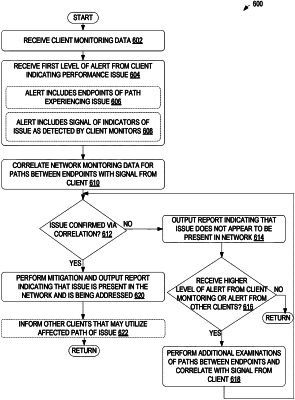| CPC H04L 43/04 (2013.01) [H04L 43/02 (2013.01); H04L 43/0811 (2013.01); H04L 43/0829 (2013.01); H04L 43/0852 (2013.01)] | 20 Claims |

|
1. A method of monitoring a network, the method comprising:
receiving a request to monitor the network, the request including two endpoints in the network, a signal of client-based monitoring data, and a plurality of thresholds corresponding to performance signals indicated by the client-based monitoring data, the signal of client-based monitoring data including monitoring data from a perspective of a client accessing the network;
computing a first set of routes through the network between the two endpoints and aggregating network-based monitoring data for the first set of routes;
identifying one or more events on one or more routes of the first set of routes using the aggregated network-based monitoring data;
responsive to determining that the performance signals indicated by the client-based monitoring data breach a first threshold of the plurality of thresholds indicating a performance degradation, correlating the one or more events, identified using the aggregated network-based monitoring data, with the client-based monitoring data to determine whether the performance degradation indicated by the client-based monitoring data breaching the first threshold is confirmed with the network-based monitoring data to be related to a network issue;
responsive to determining that the performance signals indicated by the client-based monitoring data breach a second threshold of the plurality of thresholds indicating the performance degradation, computing a second, reduced set of routes through the network between the two endpoints, generating reduced aggregated network-based monitoring data for the second set of routes, and correlating events indicated by the reduced aggregated network-based monitoring data with the client-based monitoring data received via the signal to determine whether the performance degradation is confirmed to be related to the network issue;
generating a report indicating whether the performance degradation is confirmed to be related to the network issue; and
responsive to confirming the performance degradation is related to the network issue, performing a mitigation for the network issue.
|